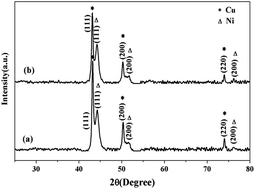Preparation and catalytic activity of magnetic bimetallic nickel/copper nanowires
Abstract
Nowadays, 4-nitrophenol (4-NP), one of the most toxic pollutants of waste water, is capturing more attention in the field of sewage disposal. In the present study, bimetallic Ni/Cu nanowires were successfully prepared via a simple approach of liquid phase reduction of Ni and transmetalation reaction of Cu assisted by a magnetic field. In addition, the bimetallic nanocomposite was developed as a new catalyst to catalyze the reduction of 4-NP for the first time. The characterization results confirmed that the as-prepared products were bimetallic Ni/Cu nanowires with admirable linear structure. Furthermore, the hysteresis loop showed that bimetallic Ni/Cu nanowires were paramagnetic materials. More importantly, the catalysis results showed that bimetallic Ni/Cu nanowires possessed appealing catalytic performance and great cycle efficiency compared with other catalysts published in the previous literature. In general, the novel catalyst is able to reduce the product costs significantly resulting from noble-metal free components and a facile preparation approach coupled with commendable catalytic performance. In addition, it is easy to separate from the reaction mixture owing to their intrinsic magnetic properties. Therefore, bimetallic Ni/Cu nanowires hold great potential for industrial effluent disposal purposes.



 Please wait while we load your content...
Please wait while we load your content...